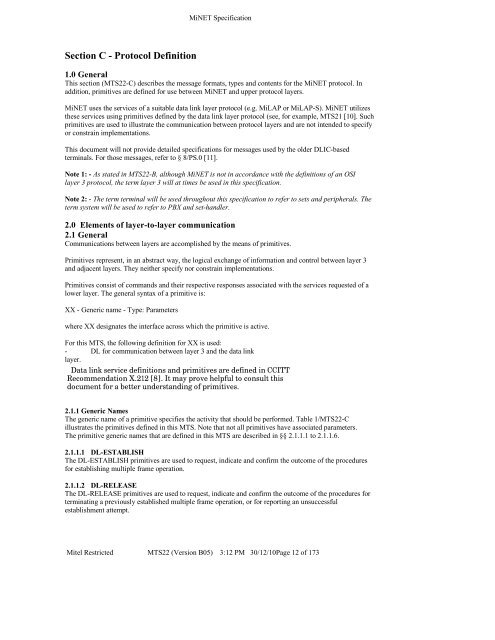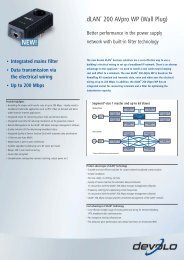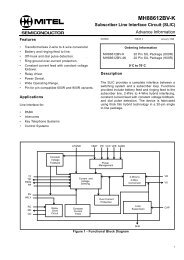Mitel Technical Specification 22
Mitel Technical Specification 22
Mitel Technical Specification 22
Create successful ePaper yourself
Turn your PDF publications into a flip-book with our unique Google optimized e-Paper software.
MiNET <strong>Specification</strong><br />
Section C - Protocol Definition<br />
1.0 General<br />
This section (MTS<strong>22</strong>-C) describes the message formats, types and contents for the MiNET protocol. In<br />
addition, primitives are defined for use between MiNET and upper protocol layers.<br />
MiNET uses the services of a suitable data link layer protocol (e.g. MiLAP or MiLAP-S). MiNET utilizes<br />
these services using primitives defined by the data link layer protocol (see, for example, MTS21 [10]. Such<br />
primitives are used to illustrate the communication between protocol layers and are not intended to specify<br />
or constrain implementations.<br />
This document will not provide detailed specifications for messages used by the older DLIC-based<br />
terminals. For those messages, refer to § 8/PS.0 [11].<br />
Note 1: - As stated in MTS<strong>22</strong>-B, although MiNET is not in accordance with the definitions of an OSI<br />
layer 3 protocol, the term layer 3 will at times be used in this specification.<br />
Note 2: - The term terminal will be used throughout this specification to refer to sets and peripherals. The<br />
term system will be used to refer to PBX and set-handler.<br />
2.0 Elements of layer-to-layer communication<br />
2.1 General<br />
Communications between layers are accomplished by the means of primitives.<br />
Primitives represent, in an abstract way, the logical exchange of information and control between layer 3<br />
and adjacent layers. They neither specify nor constrain implementations.<br />
Primitives consist of commands and their respective responses associated with the services requested of a<br />
lower layer. The general syntax of a primitive is:<br />
XX - Generic name - Type: Parameters<br />
where XX designates the interface across which the primitive is active.<br />
For this MTS, the following definition for XX is used:<br />
- DL for communication between layer 3 and the data link<br />
layer.<br />
Data link service definitions and primitives are defined in CCITT<br />
Recommendation X.212 [8]. It may prove helpful to consult this<br />
document for a better understanding of primitives.<br />
2.1.1 Generic Names<br />
The generic name of a primitive specifies the activity that should be performed. Table 1/MTS<strong>22</strong>-C<br />
illustrates the primitives defined in this MTS. Note that not all primitives have associated parameters.<br />
The primitive generic names that are defined in this MTS are described in §§ 2.1.1.1 to 2.1.1.6.<br />
2.1.1.1 DL-ESTABLISH<br />
The DL-ESTABLISH primitives are used to request, indicate and confirm the outcome of the procedures<br />
for establishing multiple frame operation.<br />
2.1.1.2 DL-RELEASE<br />
The DL-RELEASE primitives are used to request, indicate and confirm the outcome of the procedures for<br />
terminating a previously established multiple frame operation, or for reporting an unsuccessful<br />
establishment attempt.<br />
<strong>Mitel</strong> Restricted MTS<strong>22</strong> (Version B05) 3:12 PM 30/12/10Page 12 of 173





